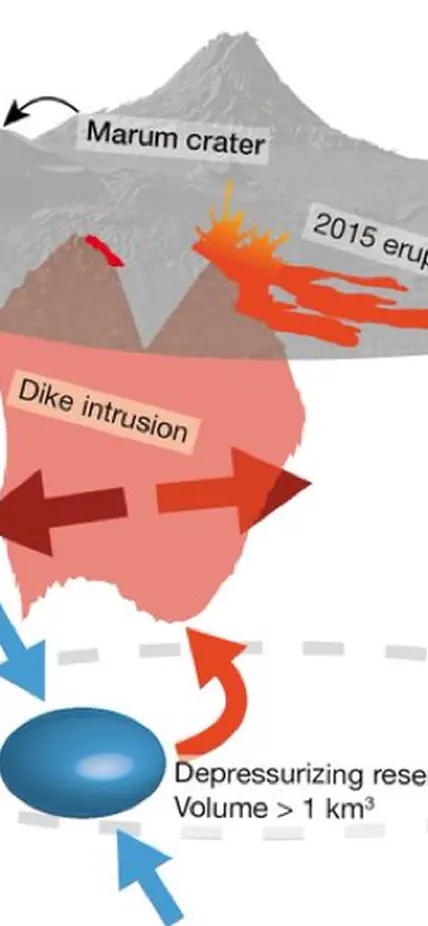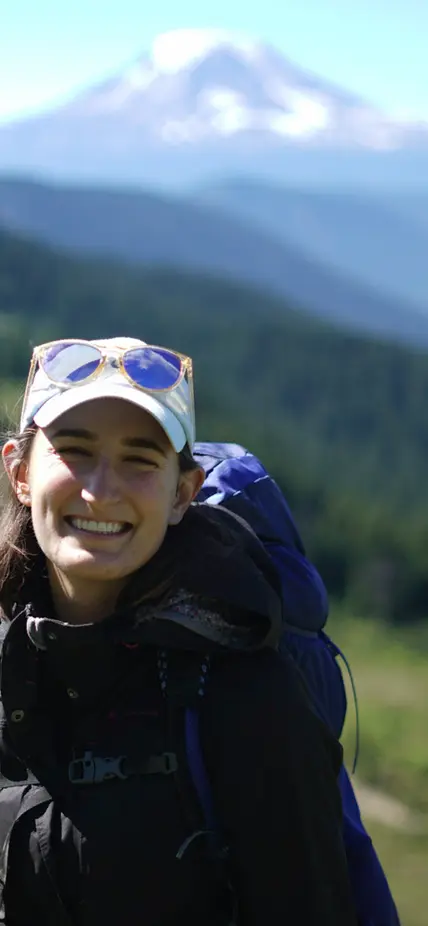Tara Shreve is a volcano geodesist who joined the Carnegie Earth and Planets Laboratory as a postdoctoral fellow in January 2021. After her B.Sc. from American University, she traveled abroad to Paris for her M.Sc. and Ph.D. from the Institut de Physique du Globe de Paris (IPGP). Now, she works with Hélène Le Mével to measure subtle changes in the Earth’s surface before, during, and after volcanic eruptions.
Watching a volcano change shape from above can provide a surprising amount of information about what is happening beneath the surface. Her recent work focused on the inner workings of the Ambrym volcano—a volcano in the Vanuatu archipelago in the South Pacific Ocean. That work shed new light on how much magma is stored beneath the volcano and how the volcano’s consistent degassing of sulfur dioxide affects the storage of that magma.
In this interview, Shreve goes into more detail about this project, shares how she got interested in volcanology, and gives advice to current grad students.
What is your area of research, and why is it important?
In my research, I use data from space-based radar satellites to measure the motion of the ground before, during, and after volcanic eruptions. Using a technique called Interferometric Synthetic Aperture Radar (InSAR), we can measure the motion of the Earth’s surface that is as subtle as a few centimeters, or as large as a few meters. Because this is a space-based remote sensing technique, measurements can be made at pretty much any active volcano worldwide, even those that are dangerous and inaccessible.
I also use complementary modeling techniques to explore the physical mechanisms causing these changes to the Earth. At volcanoes, for example, these changes may be caused by molten rock moving from a storage region (called a magma reservoir) towards the surface before an eruption, or due to pressure build-up (from new magma or exsolved gas) in the underground magma reservoirs.
What are the larger implications of your work?
There are many models used to describe a volcanic system, and most are relatively simple. In other words, they only consider a few aspects of the entire volcanic system (the response of the rock, for example, to an underground pressure build-up).
These models are fast and efficient, but because of their simplicity, they require numerous assumptions to be made about the properties of the crust or the shape of the magma reservoir, for example. Ultimately, I’m interested in determining when and how these simple models can be utilized in near real-time response to volcanic eruptions and when other more complex models can be leveraged instead.
What have you been working on recently?

Summary graphic from Tara Shreve's recent publication which shows InSAR measured co-eruptive deformation associated with a dike intrusion, caldera ring-fault slip, and reservoir deflation.
Much of my recent research has focused on volcanoes in the Southwest Pacific, specifically a very active volcano called Ambrym in Vanuatu.
My Ph.D. research investigated ground deformation using InSAR at Ambrym over the past 15 years. For decades, Ambrym hosted active lava lakes and emitted large amounts of sulfur dioxide each day, but there are very few studies discussing where and how much magma is stored beneath the volcano. My Ph.D. work added additional constraints to answer these questions, as well as provided insights on the formation of the volcano’s caldera and how its persistent degassing affects the storage and replenishment of magma over year-long periods.
What inspired you to choose this field of study?
I first became interested in studying volcanoes after writing bulletins on volcanic activity for the Global Volcanism Program (GVP) at the Smithsonian National Museum of Natural History my sophomore year in college. I was studying math and physics at the time, and my mentors at the GVP convinced me that this foundation could be applied to Earth sciences through the field of geophysics.
How has your background influenced your research?
Thanks to my parents, I grew up enjoying the outdoors, but it wasn’t until a summer spent working in Yosemite National Park after my freshman year in college that I began to be curious about the forces that shape our planet. I also started rock climbing around the same time, which got me thinking about how various rocks were formed and brought to be exposed at the Earth’s surface through geological and tectonic processes.
Has anything else affected your thinking as a scientist?
Living and studying abroad in graduate school affected the way I think and communicate as a scientist. Learning how to overcome language barriers helped me develop skills to communicate my research effectively. In my opinion, this is one of the most difficult aspects of science, and something I’m constantly working to improve.
When you're not actively researching, do you have any hobbies?
Yes! The nature of my research means that I spend a lot of time behind the computer, so in my free time I like to be outdoors. You can find me rock climbing, hiking, or biking on most weekends. I’m also a big fan of food (I blame this on 5 years spent in France), so I like cooking and preferably sharing home-cooked meals with good company.
Why did you choose the Earth and Planets Laboratory?
Carnegie is an excellent place to do research as an early career scientist. Personally, I was excited to work with Hélène Le Mével because I was interested in learning more about her novel modeling of magma dynamics that can be used to explain ground deformation and gravity data.
In addition, Carnegie’s fellowship program allows postdocs time and resources to explore and develop their own research projects, which cultivates intellectual and scientific independence at an important stage in one’s career.
What's next for you? Any projects coming up?
I’m looking forward to presenting some new results at the AGU Fall Meeting alongside collaborators from Europe and Chile, including a study concerning the 2018 eruption of Sierra Negra in the Galápagos.
Do you have any advice for current graduate students?
It’s never too early to think about how your research fits into the bigger picture of your field. If you are excited about the future of your research field, that enthusiasm will spread and help you stay motivated when times get tough!
Also, you can never drink too much tea.
Shreve has been working remotely through COVID but will be coming to campus in September. Learn more about her and her work on her website or connect with her on Twitter (@TaraShreve).
